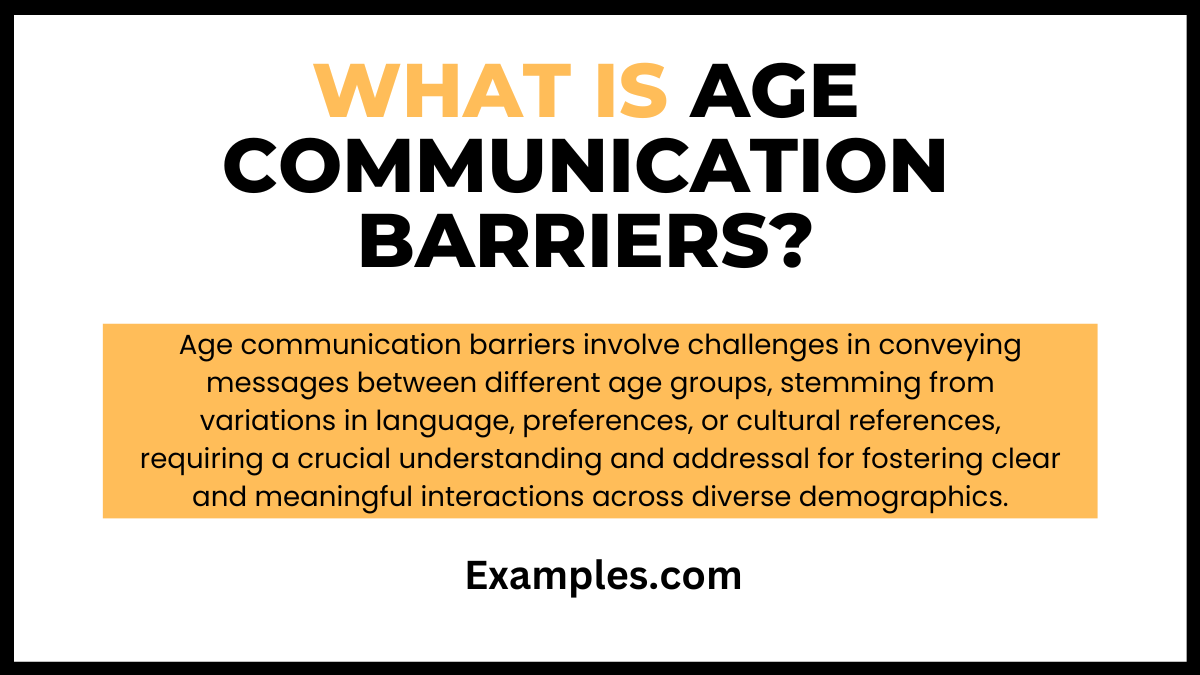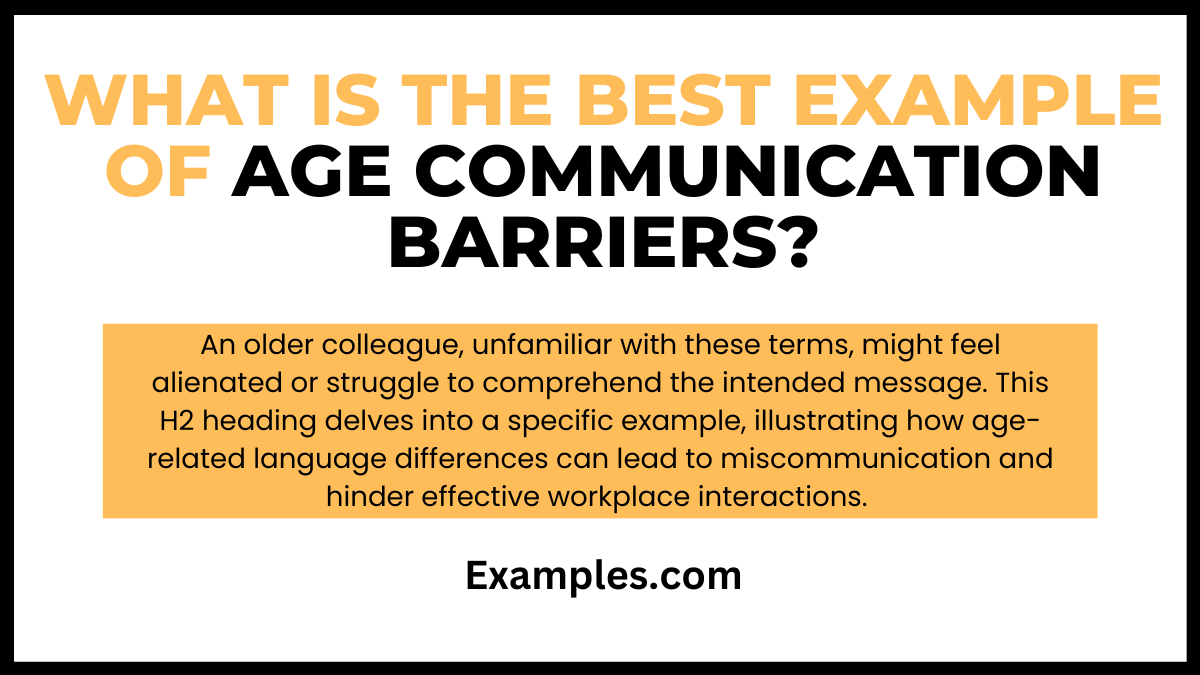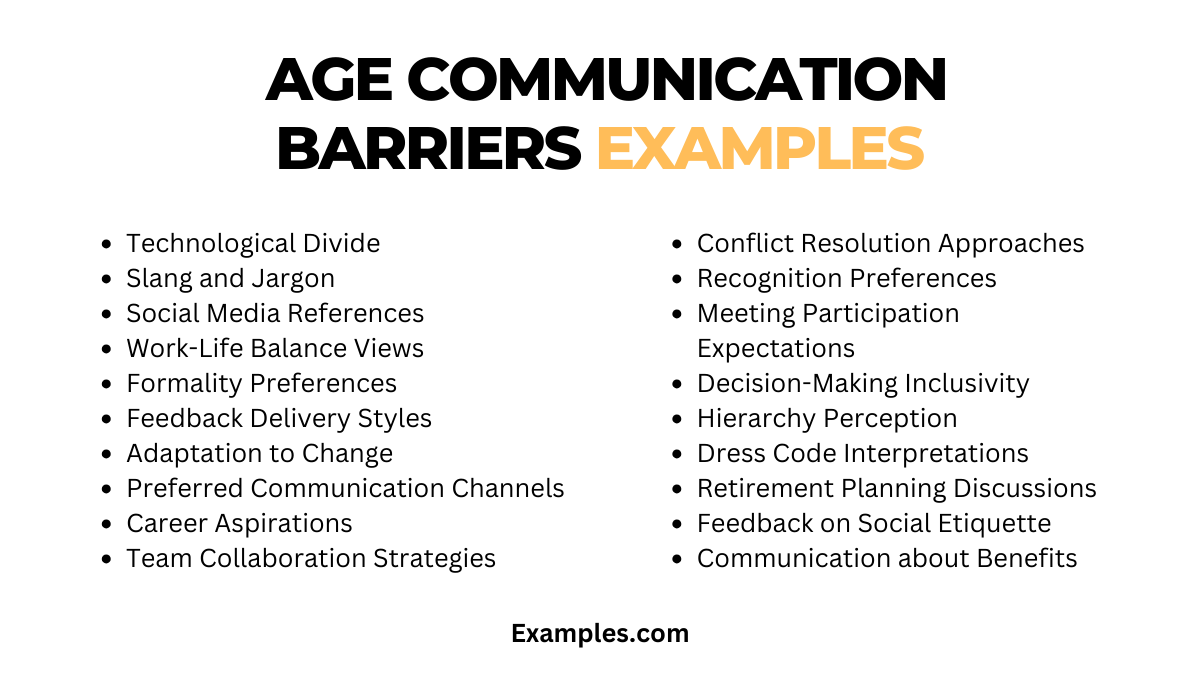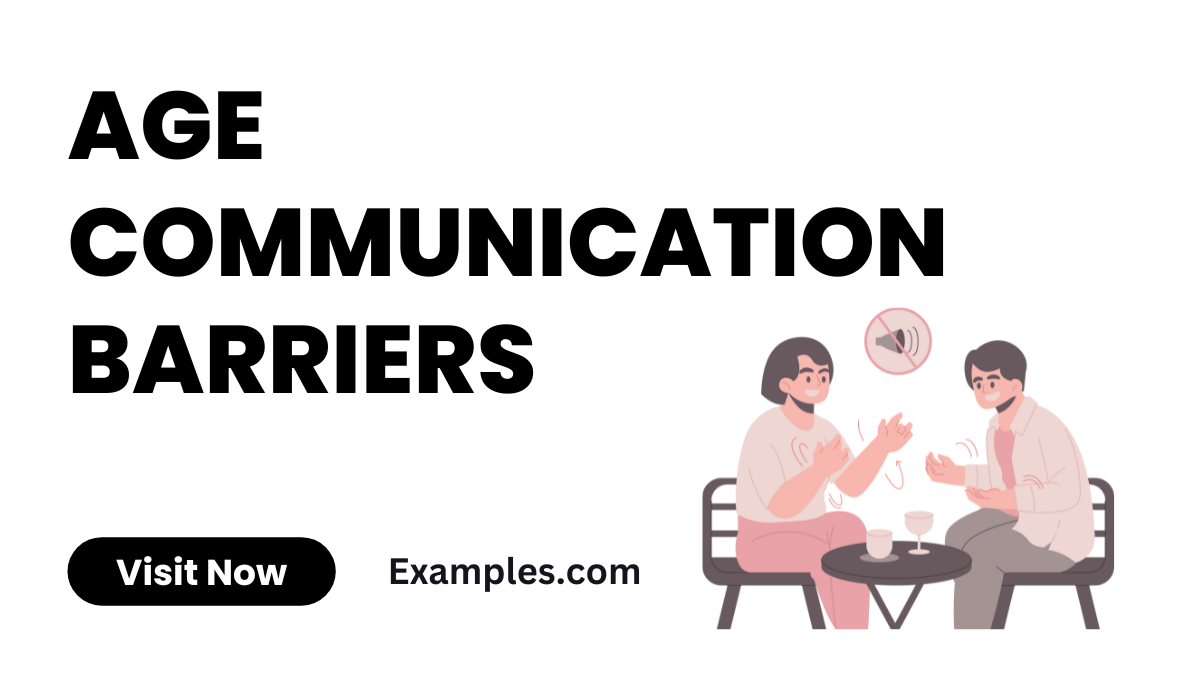19+ Age Communication Barriers Examples
Embark on a comprehensive exploration of Age Communication Barriers in this illuminating guide. Uncover the nuances of effective communication across generations, complete with practical tips and illuminating Communication Examples. From bridging generation gaps to mastering inclusive dialogue, gain valuable insights to navigate age-related challenges and enhance your communication prowess. Elevate your interactions by delving into this insightful guide tailored to foster clearer and more connected communication across diverse age groups.
What is Age Communication Barriers?

Age communication barriers refer to challenges in conveying messages between individuals of different age groups. These hurdles may arise due to variations in language, preferences, or cultural references. In simpler words, it’s the difficulty in effectively exchanging information caused by differences in age-related communication styles and understanding. Understanding and addressing these barriers are crucial for fostering clear and meaningful interactions across diverse age demographics.
What is the Best Example of Age Communication Barriers?

Consider a scenario where a younger employee uses slang or contemporary expressions during a workplace meeting. An older colleague, unfamiliar with these terms, might feel alienated or struggle to comprehend the intended message. This H2 heading delves into a specific example, illustrating how age-related language differences can lead to miscommunication and hinder effective workplace interactions. Gain a comprehensive understanding of this real-life scenario to navigate and mitigate age-related communication challenges effectively.
20 Age Communication Barriers Examples

Explore examples of Age Communication Barriers in this insightful guide. Uncover practical insights into challenges faced in cross-generational communication. This SEO-friendly, NLP-friendly content provides valuable tips and strategies to bridge age-related communication gaps, fostering more effective and inclusive interactions.
- Technological Divide:
- Communicating tech-related concepts to older individuals may be challenging, impacting collaborative projects.
- Slang and Jargon:
- The use of contemporary slang may create confusion for older individuals, requiring clear and simplified language.
- Social Media References:
- Mentioning social media platforms or trends may be alienating for those less familiar with online platforms.
- Work-Life Balance Views:
- Differing perspectives on work-life balance can lead to misunderstandings and potential conflicts.
- Formality Preferences:
- Varied preferences for formal or informal communication styles can affect professional relationships.
- Feedback Delivery Styles:
- Approaches to giving and receiving feedback may differ, impacting workplace dynamics.
- Adaptation to Change:
- Resistance or reluctance to embrace change may affect communication about organizational transitions.
- Preferred Communication Channels:
- Varied preferences for email, phone calls, or messaging apps can impact efficient communication.
- Career Aspirations:
- Different views on career progression may lead to misunderstandings during performance reviews.
- Team Collaboration Strategies:
- Varying strategies for teamwork may require alignment to ensure effective collaboration.
- Learning Styles:
- Varied preferences for visual, auditory, or kinesthetic learning impact training effectiveness.
- Conflict Resolution Approaches:
- Differing approaches to resolving conflicts may require a nuanced understanding for effective resolution.
- Recognition Preferences:
- Varied preferences for public or private recognition may impact morale and motivation.
- Meeting Participation Expectations:
- Different expectations regarding active participation in meetings may cause disparities in engagement.
- Decision-Making Inclusivity:
- Ensuring inclusivity in decision-making processes requires bridging generational differences in participation.
- Hierarchy Perception:
- Perspectives on hierarchical structures can affect communication within organizational hierarchies.
- Dress Code Interpretations:
- Varied interpretations of dress codes may impact professionalism perceptions within the workplace.
- Retirement Planning Discussions:
- Approaching discussions about retirement plans requires sensitivity to diverse perspectives on the subject.
- Feedback on Social Etiquette:
- Providing feedback on social etiquette may require cultural sensitivity to generational norms.
- Communication about Benefits:
- Tailoring communication about employee benefits to suit diverse generational needs is essential for understanding and participation.
Explore these diverse examples to gain insights into age-related communication challenges and equip yourself with practical strategies for effective cross-generational interactions.
Age Communication Barriers for Students Examples
Explore the dynamic landscape of age-related communication barriers among students. This delves into the unique challenges faced by students of different ages, offering practical insights and strategies for effective communication within educational settings.
- Technology Divide in Group Projects:
- Collaborating on tech-intensive assignments may pose challenges, with younger students navigating seamlessly while older peers may struggle.
- Learning Style Preferences:
- Varied learning preferences can create barriers, impacting group study sessions. Encouraging adaptable teaching methods can enhance inclusivity.
- Generational Differences in Study Habits:
- Varied approaches to studying may lead to misunderstandings. Promoting open discussions can bridge gaps and foster a collaborative learning environment.
- Navigating Social Media Usage:
- Integrating social media into academic discussions may alienate older students. Clear communication on the relevance and optional nature is essential.
- Balancing Extracurricular Activities:
- Differences in prioritizing extracurricular activities may lead to misunderstandings. Establishing open dialogue fosters understanding and collaboration among students.
Age Communication Barriers for Adults Examples
Navigate age-related communication complexities in adult interactions. Explore practical strategies and insights to enhance communication effectiveness in diverse professional and personal settings.
- Workplace Technology Adoption:
- Introducing new technologies at the workplace may be met with resistance from older employees. Clear communication on benefits can ease the transition.
- Leadership Styles in Team Dynamics:
- Varied leadership styles may create communication gaps. Encouraging diverse perspectives and open dialogue promotes effective teamwork.
- Professional Development Approaches:
- Perspectives on career development and training may differ. Establishing personalized plans and fostering continuous learning bridges these communication gaps.
- Retirement Planning Discussions:
- Conversations about retirement planning may invoke diverse reactions. Tactful communication, tailored to individual preferences, ensures a supportive approach.
- Remote Work Adaptation:
- Embracing remote work may present challenges for older employees. Clear communication and training on digital tools foster seamless transitions and understanding.
Explore these age-specific examples and strategies to enhance communication in various contexts, promoting inclusive and effective interactions.
How to overcome age barriers in communication?
Navigating diverse age groups requires proactive strategies to bridge communication gaps. This guide explores practical and effective ways to overcome age-related barriers, fostering clearer and more harmonious interactions in various settings.
1. Foster Open Communication:
- Encourage open dialogue where individuals feel comfortable expressing concerns or seeking clarification about age-related communication challenges.
2. Develop Cultural Sensitivity:
- Enhance awareness of cultural nuances associated with different age groups, promoting understanding and empathy in communication.
3. Embrace Technology Training:
- Provide training sessions to familiarize older individuals with newer technologies, ensuring they feel confident in digital communication.
4. Implement Intergenerational Mentorship Programs:
- Establish mentorship programs to facilitate knowledge exchange and understanding between different age groups in professional settings.
5. Tailor Communication Styles:
- Adapt communication styles to suit the preferences of different age groups, ensuring clarity and resonance with diverse audiences.
6. Promote Collaboration and Team-Building Activities:
- Foster collaboration through team-building activities that encourage interaction and understanding among individuals of varying ages.
7. Use Multimodal Communication Tools:
- Utilize diverse communication channels, including written, verbal, and visual methods, to cater to different age-related learning preferences.
8. Provide Continuous Learning Opportunities:
- Offer ongoing learning opportunities to individuals of all ages, promoting a culture of adaptability and lifelong learning.
9. Encourage Cross-Generational Feedback:
- Establish a feedback culture where individuals of different age groups can provide insights, fostering mutual understanding and improvement.
10. Establish Inclusive Policies:
- Implement inclusive policies that consider the diverse needs and preferences of individuals across different age brackets.
What are the effects of Age Communication Barriers?
Age-related communication barriers can significantly impact various aspects of the workplace. This comprehensive guide explores the multifaceted effects, shedding light on how these barriers influence relationships, productivity, and organizational culture.
1. Workplace Misunderstandings:
- Impact: Divergent communication styles may lead to misunderstandings, affecting collaboration and project outcomes.
- Resolution: Promote open communication channels, fostering an environment where team members feel comfortable seeking clarification.
2. Reduced Productivity:
- Impact: Age-related miscommunications can result in decreased productivity due to delays and errors.
- Resolution: Implement clear communication protocols and emphasize the importance of concise and unambiguous messaging.
3. Strained Interpersonal Relationships:
- Impact: Communication gaps may strain relationships among team members, leading to decreased morale.
- Resolution: Facilitate team-building activities and encourage cross-generational collaboration to improve interpersonal dynamics.
4. Resistance to Change:
- Impact: Age-related communication barriers may contribute to resistance to organizational changes.
- Resolution: Communicate the benefits and rationale behind changes transparently, addressing concerns and fostering a culture of adaptability.
5. Knowledge Transfer Challenges:
- Impact: Difficulty in conveying knowledge across generations can hinder effective knowledge transfer.
- Resolution: Implement mentorship programs, encouraging knowledge exchange and creating a culture of continuous learning.
6. Diversity and Inclusion Issues:
- Impact: Age-related miscommunications may contribute to feelings of exclusion among certain age groups.
- Resolution: Promote inclusivity through awareness programs, diversity training, and creating forums for open dialogue.
7. Leadership and Management Challenges:
- Impact: Effective leadership may be compromised if communication gaps exist between leaders and different age groups.
- Resolution: Provide leadership training that addresses cross-generational communication, emphasizing understanding and adaptability.
8. Impact on Employee Engagement:
- Impact: Communication barriers can diminish employee engagement, affecting job satisfaction.
- Resolution: Foster a communicative culture where employees feel heard, valued, and included in decision-making processes
Tips for Effective Age Communication Barriers?
Navigating age-related communication challenges requires strategic approaches for fostering understanding and collaboration across diverse generations. This comprehensive guide provides practical tips and actionable strategies to enhance communication effectiveness in a multigenerational workplace.
1. Foster Open Dialogue:
- Encourage open communication channels to address concerns, share perspectives, and create an inclusive environment for cross-generational conversations.
2. Promote Active Listening:
- Cultivate active listening skills among all team members to ensure mutual understanding and respect for diverse viewpoints.
3. Provide Cross-Generational Training:
- Implement training programs that focus on enhancing cross-generational communication skills, fostering empathy, and promoting effective collaboration.
4. Use Inclusive Language:
- Adopt language that is inclusive and accessible to individuals of different age groups, avoiding jargon or references that may exclude certain generations.
5. Embrace Technological Inclusion:
- Facilitate technology training sessions to bridge the digital divide, ensuring all team members are comfortable with the tools and platforms used in the workplace.
6. Establish Mentorship Programs:
- Develop mentorship initiatives that facilitate knowledge exchange between experienced employees and newer generations, promoting a culture of continuous learning.
7. Encourage Multigenerational Teams:
- Form diverse project teams that include members from various age groups, leveraging the strengths and perspectives of each generation.
8. Clarify Expectations:
- Clearly communicate expectations regarding communication styles, work preferences, and collaboration approaches to avoid misunderstandings.
In conclusion, this guide illuminates the complexities of age communication barriers with real-life examples, offering insights to foster understanding. By acknowledging and addressing these challenges, individuals and organizations can pave the way for clearer, more inclusive interactions across generations. Navigating age-related communication hurdles is essential for cultivating harmonious and effective relationships in diverse workplaces.



